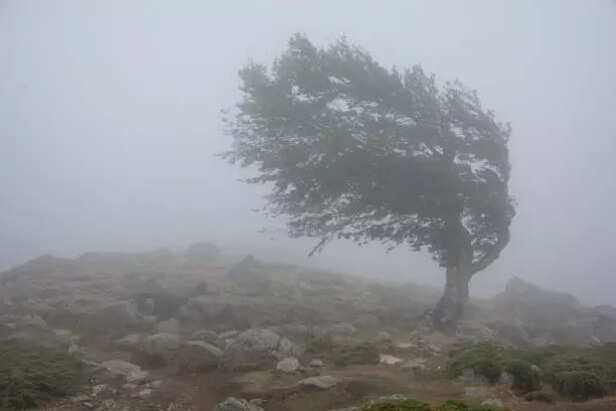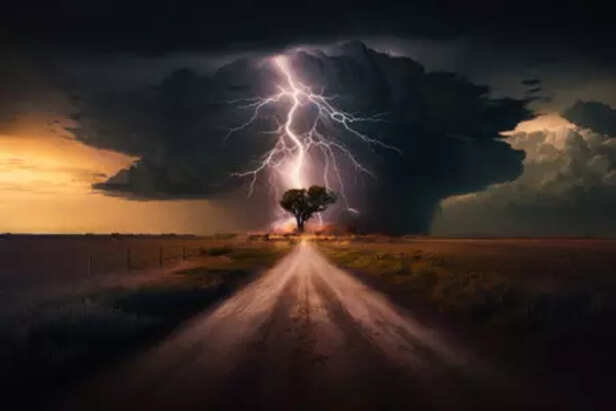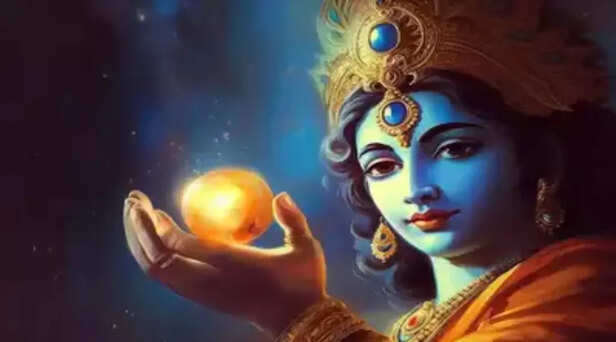If A Tree Does Not Know How to Dance, The Wind Will Teach It
Ankit Gupta | May 05, 2025, 17:07 IST

Krishna is the ultimate teacher who, like the wind, guides us toward the dance of life, where we move in harmony with the universe, finding our purpose through surrender and trust in the divine guidance he offers.
The metaphor, "If a tree does not know how to dance, the wind will teach it," beautifully captures the essence of how life shapes us. It is a profound statement about the nature of transformation, the challenges we face, and the unseen forces that guide us through it. The tree, in this metaphor, represents the soul, and the wind symbolizes the divine forces, often represented in the Bhagavad Gita by Shree Krishna. Just as the wind moves the tree into its natural rhythm, Krishna guides the soul through the uncertainties and complexities of life, teaching it to dance in harmony with the universe.
In the Bhagavad Gita, Krishna, the divine teacher, plays the role of the guiding wind, leading Arjuna (and all of humanity) to spiritual awakening and self-realization. Through his teachings, Krishna shows how the soul can navigate life’s storms, surrendering to divine will, and transforming its actions into paths that lead toward liberation (moksha). This essay explores how Krishna, like the wind, shapes the tree of our lives through his guidance, surrender, and transformative wisdom.

In the Bhagavad Gita, Krishna is not merely a teacher; he is the divine guide who leads the soul through the stormy confusion and suffering of life. The wind, as an unseen force, shapes the tree’s movement, much like Krishna’s divine will shapes the direction of the soul. Arjuna, in his moment of crisis on the battlefield, finds himself lost in confusion, not knowing what to do in the face of duty and ethical dilemmas. He represents the tree that does not understand its purpose or the forces shaping its direction.
Krishna, the wind, speaks to him with wisdom, encouraging him to rise above his confusion and embrace his dharma (righteous duty). Arjuna, like the tree, does not initially understand why he must take the difficult path of battle, but Krishna’s guidance helps him see the larger cosmic picture.
Krishna’s teachings in the Bhagavad Gita act as the divine wind that moves the tree of Arjuna's life in the right direction. Krishna reveals that life’s challenges are not obstacles but opportunities for growth and spiritual awakening. Just as the wind does not harm the tree but helps it grow, Krishna’s teachings, though challenging, are aimed at shaping the soul toward its higher purpose.
In Chapter 4, Verse 7 of the Bhagavad Gita, Krishna tells Arjuna:
"Whenever there is a decline in righteousness and an increase in unrighteousness, O Arjuna, at that time I manifest myself on earth."
Here, Krishna explains that whenever the world is in chaos, he incarnates to restore order and guide the soul back to its true purpose. Like the wind guiding the tree through a storm, Krishna comes to guide souls through the tumult of life, helping them find their path to salvation.

The central theme of the Bhagavad Gita is surrender to divine will. Arjuna, faced with the enormity of his task and the emotional turmoil of fighting his own kin, is reluctant to act. Krishna encourages him to surrender his personal will to the divine plan. This act of surrender is not one of passivity, but rather an active trust in the divine rhythm that governs the universe. Similarly, the tree does not resist the wind; it moves with it, trusting the natural flow of forces.
In Bhagavad Gita 18.66, Krishna tells Arjuna:
"Surrender all your works to me, with your mind focused on me, the Lord, and fight without desire for results."
This statement highlights the importance of surrendering not just the actions but also the attachment to their outcomes. The tree, though not aware of the final result of its movement, follows the wind without question. Arjuna, too, must act according to his dharma, without worrying about success or failure.
Surrender, in this context, is the soul’s recognition that it is part of a greater cosmic plan. Just as the wind moves the tree in the direction it needs to grow, Krishna moves the soul toward its higher purpose. Surrendering to Krishna’s will means letting go of ego, attachment, and personal desires, allowing divine guidance to shape one's destiny.
In Bhagavad Gita 2.47, Krishna further emphasizes:
"You have the right to perform your prescribed duties, but you are not entitled to the fruits of your actions."
This teaching encourages detachment from the outcome of our efforts and the acceptance of life as it unfolds. The tree does not question where the wind is taking it, just as Arjuna must not question the course of action Krishna lays before him.

Krishna, like the wind, is the transformative force in the universe, helping the soul move beyond its limitations. Just as the tree may not understand how it is moving but grows through the influence of the wind, the soul may not fully grasp the purpose behind its experiences, yet it evolves through the guidance of Krishna’s wisdom.
In Bhagavad Gita 7.8, Krishna explains:
"I am the one who holds the wind, the fire, and the sun. I am the source of all energies. Everything in this world is ultimately dependent on me."
Krishna acknowledges his role as the source of all energy in the universe. Like the wind that moves the tree, Krishna’s energy moves the entire cosmos, shaping it according to divine will.
The process of transformation through Krishna’s guidance is not always easy, just as the tree may face violent gusts of wind that seem unsettling. However, these gusts, like life’s challenges, are necessary for growth. In this process, Krishna teaches Arjuna to transcend his doubts, attachments, and fears, enabling him to find peace and purpose in his actions.
In Bhagavad Gita 2.20, Krishna assures Arjuna of the immortal nature of the soul:
"For the soul, there is neither birth nor death at any time. It is not slain when the body is slain."
Through Krishna’s teachings, Arjuna learns to detach from the temporary struggles of life and align himself with the eternal truth. The soul, like the tree, may face storms, but it is not destroyed by them. Instead, it is shaped and transformed into something greater.
The divine dance, represented by Krishna’s teachings, is the rhythm of life itself. Like the tree’s dance in the wind, the soul’s journey unfolds according to a divine plan. Krishna’s guidance helps the soul align with this rhythm, leading to spiritual transformation.

Krishna, in the Bhagavad Gita, is not just the teacher but also the cosmic dancer, the ultimate Nataraja. The tree’s dance with the wind mirrors the cosmic dance of the universe, where every soul plays a part in the divine orchestration of creation, preservation, and destruction.
Krishna himself is the divine rhythm that governs all actions in the universe. As the ultimate Nataraja, Krishna embodies the cosmic dance, moving all beings in harmony with the divine plan. Just as the tree moves with the wind, every soul must move in harmony with Krishna’s rhythm, surrendering to the divine will.
In Bhagavad Gita 10.8, Krishna declares:
"I am the origin of all, the ultimate reality. Through me, all things in the universe come into existence."
Krishna reveals that everything in the universe is a manifestation of his divine essence. Like the wind that moves the tree, Krishna is the unseen force guiding all beings towards their ultimate purpose.
The metaphor of the tree dancing with the wind also reflects the idea that life is not random; it is a cosmic dance where every action has meaning and purpose. Krishna’s teachings help the soul understand this rhythm and align itself with the greater flow of existence.
The Bhagavad Gita emphasizes bhakti (devotion) as the highest path to liberation. In this path, the devotee surrenders to Krishna’s grace and follows his divine guidance, just as the tree surrenders to the wind. Devotion allows the soul to align itself with the divine rhythm, moving toward liberation and enlightenment.
In Bhagavad Gita 18.66, Krishna urges Arjuna to surrender completely:
"Whosoever surrenders unto Me, with full devotion, I will take them across the ocean of worldly existence."
Here, Krishna promises that those who devote themselves to him and surrender all their actions to him will be guided to liberation. Just as the tree finds its rhythm in the wind, the devotee finds their purpose in Krishna’s grace.
The grace of Krishna is like the wind—unseen but powerful, shaping the life of the devotee toward its highest form. By surrendering to Krishna’s will, the devotee enters the cosmic dance, flowing in harmony with the universe.
The metaphor of the tree dancing with the wind beautifully captures the essence of Krishna’s teachings in the Bhagavad Gita. Just as the wind shapes the tree’s movement, Krishna guides the soul through life’s challenges and helps it find its true purpose. Through surrender, devotion, and trust in divine guidance, the soul transforms, becoming one with the divine rhythm of the universe. Krishna, like the wind, moves the soul toward liberation, showing that the journey, though filled with uncertainties, is ultimately a path toward spiritual awakening and self-realization. The dance of life, under Krishna’s guidance, becomes a celebration of the divine will, where every movement, every step, is an expression of the cosmic rhythm that unites all beings in the dance of the universe.
In the Bhagavad Gita, Krishna, the divine teacher, plays the role of the guiding wind, leading Arjuna (and all of humanity) to spiritual awakening and self-realization. Through his teachings, Krishna shows how the soul can navigate life’s storms, surrendering to divine will, and transforming its actions into paths that lead toward liberation (moksha). This essay explores how Krishna, like the wind, shapes the tree of our lives through his guidance, surrender, and transformative wisdom.
Krishna as the Divine Guide

The Wind Leading the Tree
In the Bhagavad Gita, Krishna is not merely a teacher; he is the divine guide who leads the soul through the stormy confusion and suffering of life. The wind, as an unseen force, shapes the tree’s movement, much like Krishna’s divine will shapes the direction of the soul. Arjuna, in his moment of crisis on the battlefield, finds himself lost in confusion, not knowing what to do in the face of duty and ethical dilemmas. He represents the tree that does not understand its purpose or the forces shaping its direction.
Krishna, the wind, speaks to him with wisdom, encouraging him to rise above his confusion and embrace his dharma (righteous duty). Arjuna, like the tree, does not initially understand why he must take the difficult path of battle, but Krishna’s guidance helps him see the larger cosmic picture.
Krishna’s teachings in the Bhagavad Gita act as the divine wind that moves the tree of Arjuna's life in the right direction. Krishna reveals that life’s challenges are not obstacles but opportunities for growth and spiritual awakening. Just as the wind does not harm the tree but helps it grow, Krishna’s teachings, though challenging, are aimed at shaping the soul toward its higher purpose.
In Chapter 4, Verse 7 of the Bhagavad Gita, Krishna tells Arjuna:
"Whenever there is a decline in righteousness and an increase in unrighteousness, O Arjuna, at that time I manifest myself on earth."
Here, Krishna explains that whenever the world is in chaos, he incarnates to restore order and guide the soul back to its true purpose. Like the wind guiding the tree through a storm, Krishna comes to guide souls through the tumult of life, helping them find their path to salvation.
Surrendering to the Divine Will

Tree’s Acceptance of the Wind
The central theme of the Bhagavad Gita is surrender to divine will. Arjuna, faced with the enormity of his task and the emotional turmoil of fighting his own kin, is reluctant to act. Krishna encourages him to surrender his personal will to the divine plan. This act of surrender is not one of passivity, but rather an active trust in the divine rhythm that governs the universe. Similarly, the tree does not resist the wind; it moves with it, trusting the natural flow of forces.
In Bhagavad Gita 18.66, Krishna tells Arjuna:
"Surrender all your works to me, with your mind focused on me, the Lord, and fight without desire for results."
This statement highlights the importance of surrendering not just the actions but also the attachment to their outcomes. The tree, though not aware of the final result of its movement, follows the wind without question. Arjuna, too, must act according to his dharma, without worrying about success or failure.
Surrender, in this context, is the soul’s recognition that it is part of a greater cosmic plan. Just as the wind moves the tree in the direction it needs to grow, Krishna moves the soul toward its higher purpose. Surrendering to Krishna’s will means letting go of ego, attachment, and personal desires, allowing divine guidance to shape one's destiny.
In Bhagavad Gita 2.47, Krishna further emphasizes:
"You have the right to perform your prescribed duties, but you are not entitled to the fruits of your actions."
This teaching encourages detachment from the outcome of our efforts and the acceptance of life as it unfolds. The tree does not question where the wind is taking it, just as Arjuna must not question the course of action Krishna lays before him.
Krishna’s Role in Transformation

The Dance of Life
Krishna, like the wind, is the transformative force in the universe, helping the soul move beyond its limitations. Just as the tree may not understand how it is moving but grows through the influence of the wind, the soul may not fully grasp the purpose behind its experiences, yet it evolves through the guidance of Krishna’s wisdom.
In Bhagavad Gita 7.8, Krishna explains:
"I am the one who holds the wind, the fire, and the sun. I am the source of all energies. Everything in this world is ultimately dependent on me."
Krishna acknowledges his role as the source of all energy in the universe. Like the wind that moves the tree, Krishna’s energy moves the entire cosmos, shaping it according to divine will.
The process of transformation through Krishna’s guidance is not always easy, just as the tree may face violent gusts of wind that seem unsettling. However, these gusts, like life’s challenges, are necessary for growth. In this process, Krishna teaches Arjuna to transcend his doubts, attachments, and fears, enabling him to find peace and purpose in his actions.
In Bhagavad Gita 2.20, Krishna assures Arjuna of the immortal nature of the soul:
"For the soul, there is neither birth nor death at any time. It is not slain when the body is slain."
Through Krishna’s teachings, Arjuna learns to detach from the temporary struggles of life and align himself with the eternal truth. The soul, like the tree, may face storms, but it is not destroyed by them. Instead, it is shaped and transformed into something greater.
The divine dance, represented by Krishna’s teachings, is the rhythm of life itself. Like the tree’s dance in the wind, the soul’s journey unfolds according to a divine plan. Krishna’s guidance helps the soul align with this rhythm, leading to spiritual transformation.
Krishna as the Cosmic Dance

Lord of the Universe (Image Credit: Pixels)
Krishna, in the Bhagavad Gita, is not just the teacher but also the cosmic dancer, the ultimate Nataraja. The tree’s dance with the wind mirrors the cosmic dance of the universe, where every soul plays a part in the divine orchestration of creation, preservation, and destruction.
Krishna himself is the divine rhythm that governs all actions in the universe. As the ultimate Nataraja, Krishna embodies the cosmic dance, moving all beings in harmony with the divine plan. Just as the tree moves with the wind, every soul must move in harmony with Krishna’s rhythm, surrendering to the divine will.
In Bhagavad Gita 10.8, Krishna declares:
"I am the origin of all, the ultimate reality. Through me, all things in the universe come into existence."
Krishna reveals that everything in the universe is a manifestation of his divine essence. Like the wind that moves the tree, Krishna is the unseen force guiding all beings towards their ultimate purpose.
The metaphor of the tree dancing with the wind also reflects the idea that life is not random; it is a cosmic dance where every action has meaning and purpose. Krishna’s teachings help the soul understand this rhythm and align itself with the greater flow of existence.
The Path of Devotion and Krishna’s Grace
In Bhagavad Gita 18.66, Krishna urges Arjuna to surrender completely:
"Whosoever surrenders unto Me, with full devotion, I will take them across the ocean of worldly existence."
Here, Krishna promises that those who devote themselves to him and surrender all their actions to him will be guided to liberation. Just as the tree finds its rhythm in the wind, the devotee finds their purpose in Krishna’s grace.
The grace of Krishna is like the wind—unseen but powerful, shaping the life of the devotee toward its highest form. By surrendering to Krishna’s will, the devotee enters the cosmic dance, flowing in harmony with the universe.
The metaphor of the tree dancing with the wind beautifully captures the essence of Krishna’s teachings in the Bhagavad Gita. Just as the wind shapes the tree’s movement, Krishna guides the soul through life’s challenges and helps it find its true purpose. Through surrender, devotion, and trust in divine guidance, the soul transforms, becoming one with the divine rhythm of the universe. Krishna, like the wind, moves the soul toward liberation, showing that the journey, though filled with uncertainties, is ultimately a path toward spiritual awakening and self-realization. The dance of life, under Krishna’s guidance, becomes a celebration of the divine will, where every movement, every step, is an expression of the cosmic rhythm that unites all beings in the dance of the universe.
